The Meaning and Importance of Friendship Symbols
Friendship symbols, such as friendship bracelets, Claddagh rings, or the infinity symbol, are rich in meaning and history, embodying the essence of connection, loyalty, and the joys of shared experiences. These symbols transcend mere ornaments, serving as tangible reminders of the bonds that tie friends together across various cultures and epochs. Each symbol carries a unique story and significance, deepening the meaning of the friendships they represent and offering comfort and a sense of belonging.

Historical and Cultural Significance of Friendship Symbols
Across the globe, different cultures have developed unique symbols to represent the bonds of friendship. The friendship bracelet, originally from Central America, is woven with colorful threads and is thought to bring good luck to the wearer, especially when given by a friend. Historically, these bracelets were made as tokens of friendship to celebrate and solidify the bonds between new friends and to symbolize the wish for good luck and prosperity for the wearer.
The Claddagh ring, hailing from Ireland, features two hands clasping a heart topped with a crown. Each element of the ring holds a significant meaning: the hands represent friendship, the heart symbolizes love, and the crown stands for loyalty. Although often associated with romantic relationships, the Claddagh ring is also a powerful symbol of platonic friendship, particularly when worn with the heart pointing outward toward the fingertips.
In Eastern cultures, particularly in India, the “Jai Mala” garlands used in weddings originated as a symbol of respect and friendship. These garlands, exchanged during the ceremony, are not just decorative but are deeply symbolic, woven with flowers that represent a life of happiness and prosperity, wished upon friends and loved ones.
African cultures, such as the Maasai, use beaded necklaces to signify not only social status but also friendship. Each bead and color pattern has specific meanings and tells stories of community bonds and friendships that are crucial to social structure and personal relationships.
These symbols are not only a part of historical tradition but continue to be relevant today as they are passed down through generations, adapting to modern contexts while retaining their deep-rooted meanings. They serve as a bridge between past and present, personal and communal, enriching the bonds they symbolize.
Psychological Impact of Friendship Symbols
Psychologically, friendship symbols can significantly influence one’s mental health and emotional well-being. These symbols serve as a visual and physical reminder of a friend’s support and presence, providing comfort and reducing feelings of loneliness and anxiety. For many, carrying or wearing a symbol of friendship can act as a talisman, offering emotional security in challenging times.
These tokens also play a crucial role in identity formation and social interaction. For adolescents and young adults, exchanging symbols like friendship bracelets can help solidify group identities and foster a sense of belonging. They can also serve as a tool for socialization, helping individuals to navigate and establish social norms within their peer groups.
In therapeutic settings, friendship symbols can be used to help clients articulate and explore their feelings about relationships. They can aid in discussions about values such as loyalty, trust, and mutual support—key components of healthy relationships. Moreover, these symbols can help individuals reflect on their interpersonal dynamics and encourage them to develop healthier social habits.
The act of giving and receiving these symbols can also enhance interpersonal skills such as empathy, gratitude, and generosity. These skills are essential for emotional resilience and are associated with increased happiness and satisfaction in personal relationships and life in general.
Symbols of friendship thus play a multifaceted role in psychological health by fostering connection, affirming social bonds, and supporting individual and collective identity.
Modern Expressions and Trends in Friendship Symbols
In the digital age, the expressions of friendship symbols have evolved to include virtual and digital forms. Social media platforms utilize features like “Best Friends” or “Close Friends” to allow users to categorize and prioritize relationships, adapting traditional symbols of friendship to the digital realm. These features often include special emojis, badges, or filters that signify in-group membership and closeness.
Tattoos as modern friendship symbols are increasingly popular, with friends choosing matching or complementary designs that symbolize their unique connection. These permanent marks are deeply personal and reflect the enduring nature of the bonds they represent. Each tattoo tells a story of friendship, commitment, and shared experiences, making them a powerful contemporary symbol of friendship.
Customizable jewelry has also gained popularity, allowing friends to create pieces that reflect their personal connection through specific stones, engravings, or designs. This trend highlights the importance of personalization in expressing friendship in today’s culture, where individual expression and identity are highly valued.
Friendship apps and platforms offer new ways to meet and connect with potential friends, providing spaces for shared interests and support networks. These digital tools expand the concept of friendship symbols by fostering connections that might not have been possible in a pre-digital era.
The evolution of friendship symbols from traditional artifacts to modern expressions reflects their enduring relevance. As societies change, so do how people express and celebrate their friendships, demonstrating the timeless and universal nature of this human bond.
For individuals seeking to understand more about the dynamics of friendships or to find guidance in managing their social relationships, platforms like Lumende provide access to professionals who specialize in relational therapy and social psychology. Through such resources, individuals can explore the deep meanings of friendship and the symbols that represent them, enriching their understanding and appreciation of these vital human connections.

 English
English
 Deutsch
Deutsch Français
Français